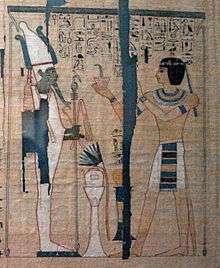High priest
The term "high priest" (or, less frequently, high priestess) usually refers either to an individual who holds the office of ruler-priest, or to one who is the head of a religious caste.
Ancient Egypt

In ancient Egypt, a high priest was the chief priest of any of the many gods revered by the Egyptians.
- High Priests of Amun The main cult of Amun was in Thebes.
- Theban High Priests of Amun While not regarded as a dynasty, the High Priests of Amun at Thebes were nevertheless of such power and influence that they were effectively the rulers of Upper Egypt from 1080 to c. 943 BC
- High Priest of Osiris. The main cult of Osiris was in Abydos.
- High Priest of Ptah. The main cult of Ptah was in Memphis.
- High Priest of Re. The main cult of Re was in Heliopolis.
- God's Wife of Amun the highest ranking priestess of the Amun cult.
Ancient Israel
The priesthood in ancient Israel had a high priest who served in the Tabernacle then in the First Temple and Second Temple in Jerusalem.
- List of High Priests of Israel.
- The Samaritan High Priest is the high priest of the Samaritan community.
Ancient World
- Archiereus title of a high priest from Ancient Greece.
- Dastur is a Zoroastrian high priest.
- Hierophant, the chief priest of the Eleusinian Mysteries.
- NIN or EN in cuneiform script, a high priest or priestess of a Sumerian city-state's patron-deity[1]
- Pontifex Maximus from Ancient Rome.
- Pythia the High Priestess of the Temple of Apollo at Delphi.
India
- Vidyaranya was a Hindu high priest in the Vijayanagara Empire.
- Panditrao was a title of the appointed high priest that sat on the Council of 8 (Ashta Pradhan) in the early Maratha Empire.
Christianity

The New Testament book of Hebrews uses the term "high priest" sixteen times; in ten of those instances Jesus Christ is explicitly or implicitly identified as the office holder (e.g. Hebrews 3:1; 4:14; and 9:11). Some Old Testament texts prophesy of a priest-king (in ancient Israel, priests and royalty were distinct, with priests from the tribe of Levi and kings from the tribes of Benjamin and Judah). Christianity views Jesus as fulfilling these prophecies, effectively replacing the former Jewish system of worship.
- Zechariah 6:13: "Even he shall build the temple of the LORD; and he shall bear the glory, and shall sit and rule upon his throne; and he shall be a priest upon his throne: and the counsel of peace shall be between them both."
- Psalm 110:2,4: "The LORD shall send the rod of thy strength out of Zion: rule thou in the midst of thine enemies. ...The LORD hath sworn, and will not repent, Thou art a priest for ever after the order of Melchizedek."
In The Church of Jesus Christ of Latter-day Saints and other Latter Day Saint sects, High Priest is also among the priesthood offices in the Melchizedek priesthood.
Other religions
- The 16th-century Maya priesthood was headed by a high priest who instructed the other priests and advised the king.
- Kahuna Nui, presides over the temple or heiau. Below the Kahuna Nui are various types and ranks of priests.
- In Shinto, a high priest, called a Guji, is usually the highest ranking priest (Kannushi) in a shrine.
- In Ásatrú, the high priest is called a goði (or gyða) and is the leader of a small group of practitioners collectively referred to as a Kindred. The goði are collectively known as the goðar.
- In both the Yoruba religion and a number of its various New World sects, such as Santeria, a high priest is called a Babalawo. The term means wise man, and comes from the Yoruba language of West Africa.
- The High Priest and High Priestess are the two highest positions of leadership and administration within the Church of Satan.
High Priest and High Priestess is also sometimes given to the members of a Pagan or Wiccan Coven when they have completed their third, or Fifth year of study and practiced. Sometimes called Third degree, depending on path or tradition.
Non-religious usages
Although the title is generally used in connection with a religious organization, some non-religious groups use it either mockingly or by tradition to reference high-ranking offices within the group. For example, in Royal Arch Masonry the Excellent High Priest serves as leader of the chapter. As the title is allegorical in nature, a reference to the Kohen Gadol, the position comes with no religious authority. The phrase is also often used to describe someone who is deemed to be an innovator or leader in a field of achievement. For example, an 1893 publication describes ancient Greek playwright Aristophanes as having been "the high-priest of comedy"[2]
Libertarian talk show host and Fair Tax proponent Neil Boortz often refers to himself on air as the "High Priest of the Church of the Painful Truth".[3]
Musician Nina Simone is often referred to as the High Priestess of Soul.
The High Priestess is the second trump or Major Arcana card in most traditional Tarot decks.
References
- ↑ Saggs, H. W. F. 1988, The Greatness That Was Babylon (revised edition)
- ↑ Maurice Maeterlinck, Charlotte Endymion Porter, Poet Lore: Volume 5 (1893), p. 246.
- ↑ Eagleton, John. "Neil Boortz's Commencement Speech". Archived from the original on 1 January 2013. Retrieved 8 October 2012.